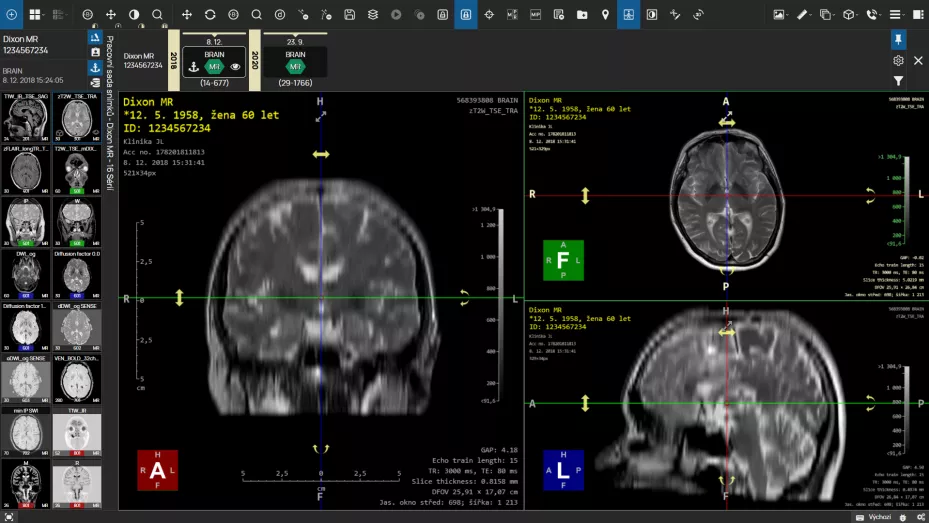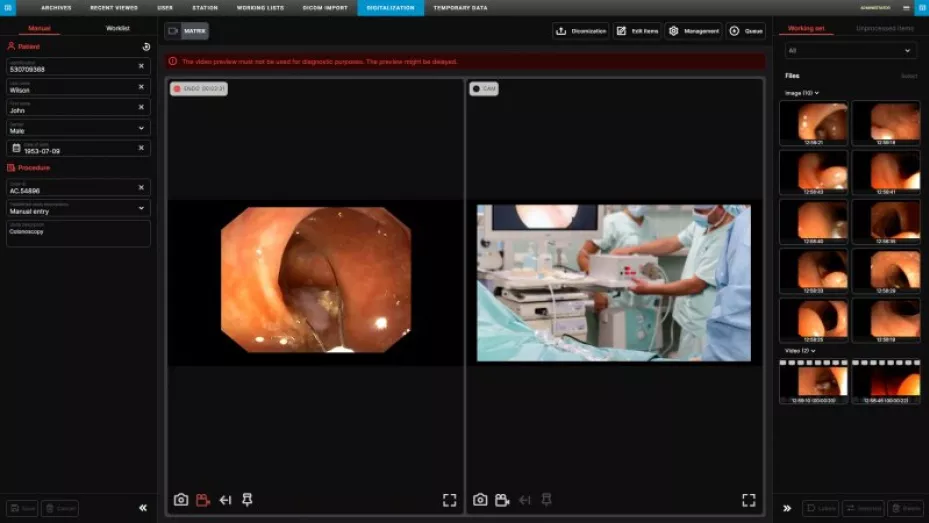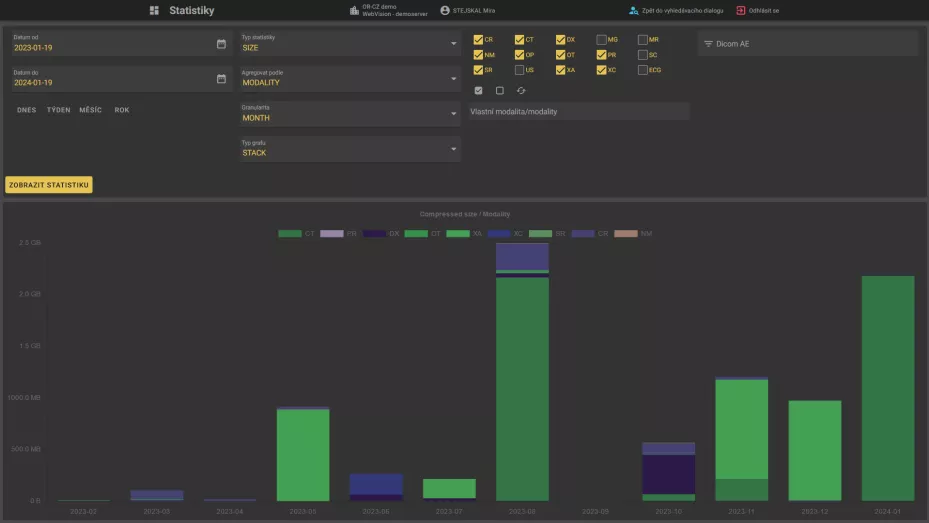
MARIE PACS
A modern, safe and reliable solution for working with medical image documentation
How will MARIE PACS help you?
MARIE PACS offers state-of-the-art tools for diagnosing image data and archiving all types of image documentation and provides a complete workflow for the radiology department.
Together with integrated tools for automated examination evaluation (AI), additional tools for communication and data sharing with other medical departments, and integration with other information systems, it provides a comprehensive solution for working with medical documentation.
Archiving
Secure archiving of DICOM and non-DICOM medical documentation, compatibility with all vendor modalities, HW independence, and no limitations on the volume or number of data stored.
Diagnostics
Web-based, zero-footprint DICOM viewer with basic and advanced diagnostic tools for instant access to images, findings, and documents.
AI
Integrated multi-vendor solutions for automatic evaluation of medical data (AI) and display of the results directly in the DICOM viewer.
Data integration and sharing
Secure communication with other health information systems (HIS, RIS) with consistent use of international standards (HL7, IHE) and tools for secure sharing of data stored in PACS and communication between healthcare facilities.
Development and certification
Certification according to MDR as a "Class IIb medical device". Development based on the requirements of customers who have been actively involved in the development process. Cooperation with colleges and universities.
24/7 service support
Our technicians provide service support 24 hours a day, 7 days a week. At the same time, our entire solution is under constant remote supervision.
Why choose MARIE PACS?
Since the start, we have been developing MARIE PACS solutions in the Czech Republic based on the requirements of physicians and taking into account the specific conditions of the healthcare sector. The scalability of our solution is confirmed by implementations in small, medium, and university hospitals as well as successful central PACS projects.
Thousands of MARIE PACS users appreciate especially the user-friendliness, service support, and gradual incorporation of their requirements in the continuous development of this product.
The key component of the entire solution is the MARIE WebVision web-based DICOM viewer. Thanks to its unique technological architecture, the viewer can be used by all medical specialists for diagnosis and clinical view, on any end device (diagnostic station, laptop, tablet, smartphone) without the need to install any software.
Selected References
Frequently asked questions
Is it possible to use the DICOM viewer separately with another PACS solution?
YES, the MARIE WebVision viewer can be installed independently of our own PACS and can therefore be connected to any PACS or other information system (VNA, NIS, RIS, EMR).
Which AI solutions is MARIE PACS connected to?
Currently, several different AI solutions are implemented in MARIE PACS. The integration is always done in a way that provides maximum convenience to the physicians and the evaluation results are available directly in the MARIE WebVision viewer environment.
Types of examination:
Lung X-ray - pulmonary opacity, atelectasis, cardiomegaly, consolidation, lung lesions, edema, diaphragm abnormalities, emphysema, fracture, pleural effusion, hilum/mediastinum abnormalities, interstitial disease, pneumothorax, kyphoscoliosis, localization of support devices, tuberculosis, pleural effusion, fluidothorax
Lung CT - identification of pulmonary nodules, highlighting the presence of nodules on each section, displaying their section and lobar location, automatic measurement of the diameter and volume of identified nodules, comparison of the characteristics of pulmonary nodules between different examinations, and generation of a final report with nodule evolution, classifying nodules as malignant/benign and assigning a set of attributes including texture, calcification, margins and fineness to each nodule, identifying the lesion caused by SARS-CoV-2 infection, displaying the degree of lung damage following SARS-CoV-2 infection
X-ray of extremities - fracture, dislocation, joint effusion
- Brain CT - intracranial, epidural, subdural, subarachnoid, intraparenchymal, intraventricular bleeding, skull fractures, mass effect: visible compression or displacement of adjacent structures, midline shift
- Mammography - replacing non-interest areas with synthetic tissue and leaving only suspicious areas, optional breast density assessment using the BI-RADS scale also called Breast Density Evaluation, creating sub-synthetic images for breast tomosynthesis, microcalcification
Preparation of measurements - gonometry, coxometry, pelvic tilt, hip dysplasia, hallux varus and hallux valgus, angles and localization, Djian-Annonier angle, CSA (Critical shoulder angle), Cobb angle, classification of scoliosis
Eye images - diabetic retinopathy, age-related macular degeneration (AMD), glaucoma
What types of examinations can be archived and imaged?
MARIE PACS allows archiving and diagnosis of standard DICOM examinations from all types of devices (X-ray, CT, MR, MG, US, ...) including video display and editing, as well as ECG waveforms. It is also possible to archive non-DICOM data. MARIE PACS has tools for the import and so-called "dicomization" of different file types - for example, JPG, PDF, MPEG, and AVI. The tools for importing non-DICOM data can also be used, for example, to take pictures of decubitus, skin diseases, injuries, etc.
Can MARIE PACS communicate with other information systems used in hospitals?
By default, MARIE PACS interfaces with hospital or radiology information systems (NIS, RIS). Communication is done using the international HL7 format. The basic interconnection is provided by:
- The transfer of information from examination requests and the creation of a worklist for individual modalities, the so-called modality worklist (MWL);
- loading and display of the text description of the examination (findings) directly in the MARIE WebVision browser environment;
- calling up the MARIE WebVision viewer directly from the NIS/RIS environment;
- automatic correction of patient demographic data.
However, the system can also be linked to other information systems, either directly or via an integration platform (ESB), using the HL7 standard or IHE profiles (XDS, AIR).
We use API interfaces to integrate the viewer into patient portals or to communicate with automated assessment (AI) systems.
Are tools for sending and sharing image documentation integrated in the system?
Our universal mDEX (medical Data EXchange) network can be used directly from the MARIE PACS environment to send medical image documentation as well as any other type of medical documentation.
The system is linked to the Dr.Sejf secure medical documentation sending tool.
In the Czech Republic, we have also integrated other ePACS and ReDiMed exchange networks into our products.
Can the DICOM viewer be used on mobile devices?
MARIE WebVision is a web-based DICOM viewer based on HTML5 technology. So, you can use it on any device - mobile phone, tablet, PC, laptop.
Can MARIE PACS be installed in virtualization?
Yes, MARIE PACS can be installed in the customer's virtual infrastructure. All standard virtualization platforms are supported - VMWare, Hyper-V, Proxmox.
Do you use paid operating or database systems?
The complete MARIE PACS solution uses the LINUX operating system and freeware database systems (Postgres, MariaDB, ...). The customer thus does not incur additional costs for the purchase of system software.

Interested in a consultation?
Miroslav Stejskal is at your disposal.
31 years on the market
With more than 31 years of experience, we offer top-quality, proven solutions and expertise.
114 specialists
Our experienced team of specialists allows us to develop and deliver innovative solutions that meet real needs.
13 000 users
Over 13 000 users trust us. Reliable products, innovative services, and a personalized approach are our priorities.






















